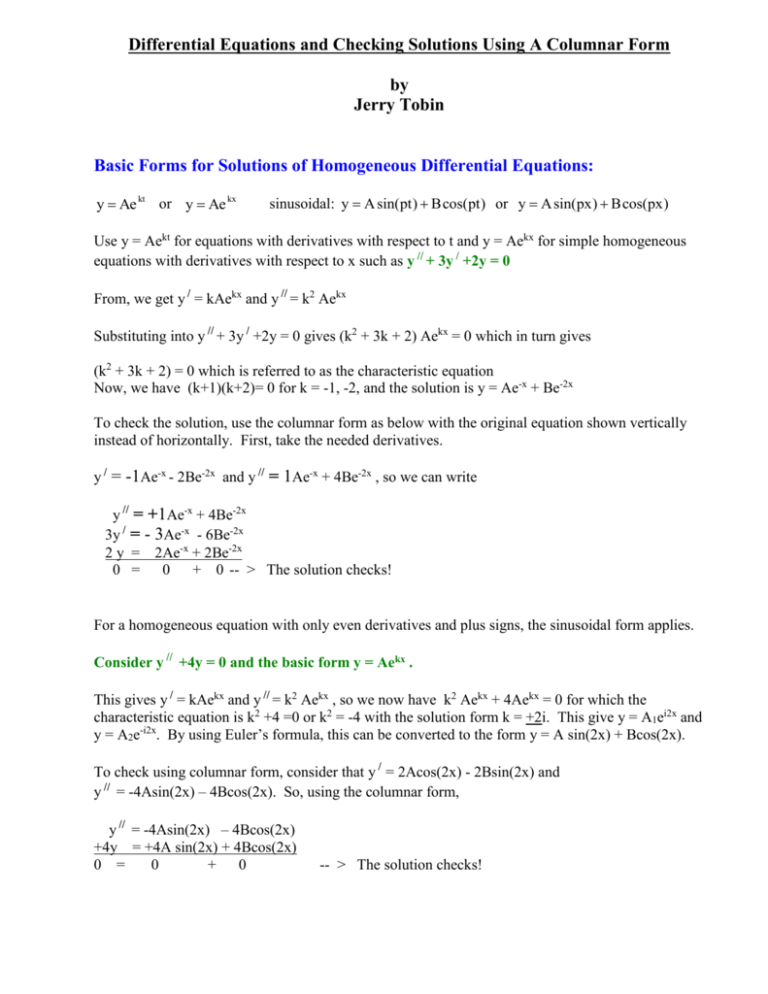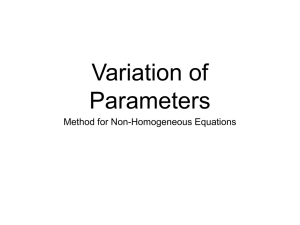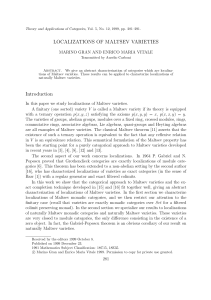Basics for Differential Equations
advertisement

Differential Equations and Checking Solutions Using A Columnar Form by Jerry Tobin Basic Forms for Solutions of Homogeneous Differential Equations: y Ae kt or y Ae kx sinusoidal: y A sin(pt) Bcos(pt) or y A sin(px) Bcos(px) Use y = Aekt for equations with derivatives with respect to t and y = Aekx for simple homogeneous equations with derivatives with respect to x such as y // + 3y / +2y = 0 From, we get y / = kAekx and y // = k2 Aekx Substituting into y // + 3y / +2y = 0 gives (k2 + 3k + 2) Aekx = 0 which in turn gives (k2 + 3k + 2) = 0 which is referred to as the characteristic equation Now, we have (k+1)(k+2)= 0 for k = -1, -2, and the solution is y = Ae-x + Be-2x To check the solution, use the columnar form as below with the original equation shown vertically instead of horizontally. First, take the needed derivatives. y / = -1Ae-x - 2Be-2x and y // = 1Ae-x + 4Be-2x , so we can write y // = +1Ae-x + 4Be-2x 3y / = - 3Ae-x - 6Be-2x 2 y = 2Ae-x + 2Be-2x 0 = 0 + 0 -- > The solution checks! For a homogeneous equation with only even derivatives and plus signs, the sinusoidal form applies. Consider y // +4y = 0 and the basic form y = Aekx . This gives y / = kAekx and y // = k2 Aekx , so we now have k2 Aekx + 4Aekx = 0 for which the characteristic equation is k2 +4 =0 or k2 = -4 with the solution form k = +2i. This give y = A1ei2x and y = A2e-i2x. By using Euler’s formula, this can be converted to the form y = A sin(2x) + Bcos(2x). To check using columnar form, consider that y / = 2Acos(2x) - 2Bsin(2x) and y // = -4Asin(2x) – 4Bcos(2x). So, using the columnar form, y // = -4Asin(2x) – 4Bcos(2x) +4y = +4A sin(2x) + 4Bcos(2x) 0 = 0 + 0 -- > The solution checks! For a non-homogeneous as above like y // + 3y / +2y = 5e-x , if the expression(s) on the right side of the equation contain the same form as the form(s) in the solution to the homogeneous equation, then you can increase the power of x for the solution form as many powers as is required to match the form to the right of the equal sign. (Hint: Solve the homogeneous equation first.) For this problem, since the solution to the homogeneous equation is known to be y = Ae-x + Be-2x , and the new equation contains a multiple of e-x , we realize that e-x is also x0e-x , and that the next power of x is x1. So the new solution form to try is yp = Cxe-x . We know that the terms for the homogeneous solution all yield zero, so we only need to test the new form to verify the answer. So, given that yp = Cxe-x , So, using the product rule, y/p = Ce-x - Cxe-x, and y//p = -2Ce-x + Cxe-x. Now, we can write y//p = -2Ce-x +1 Cxe-x +3y/p = +3Ce-x - 3Cxe-x +2y = +2Cxe-x 5e-x = Ce-x -- > C = 5 for this example. So, the solution to y // + 3y / +2y = 5e-x is y = Ae-x + Be-2x + 5xe-x . For a form such as y // + 4 y = 5 sin(2x), you need to use the product of x1 and both forms [sin(ax) and cos(ax)]. Consider that we know the solution for y // +4y = 0 to be y = Asin(2x) + Bcos(2x). Since the form to the right of the equality sign contains the same form as one of these, we also need sinusoidal form, so we use yp = Cxsin(2x) + Dxcos(2x) This gives yp / = Csin(2x) + 2Cxcos(2x) + Dcos(2x) – 2Dxsin(2x) and yp // = 4Ccos(2x) – 4Csin(2x) – 4Dsin(2x) – 4Dxcos(2x) So, using the columnar form, yp // = +4Ccos(2x) – 4Cxsin(2x) – 4Dsin(2x) – 4Dxcos(2x) +4yp = +4Cxsin(2x) + + 4Dxcos(2x) 5 sin(2x) = +4Ccos(2x) + 0 – 4Dsin(2x) + 0 For this to be true, we need 5 = – 4D or D = -5 5 and C = 0. So, for yp = 0xsin(2x) - xcos(2x), the 4 4 solution checks! This gives the solution for y // + 4 y = 5 sin(2x) to be y = A sin(2x) + Bcos(2x) - (5/4)xcos(2x) Note that the last term contains cos(2x) instead of sin(2x), so we had to use both forms, Cxsin(2x) and Dxcos(2x) to ensure that the entire solution was identified. For a non-homogeneous as above like y // + 3y / +2y = 5ex, if the expression(s) on the right side of the equation do not contain the same form as the form(s) in the solution to the homogeneous equation, then you can assume that the solution form for the homogeneous equation will not be included in the particular solution. (Hint: Be sure to solve the homogeneous equation first.) For this problem, since the solution to the homogeneous equation is known to be y = Ae-x + Be-2x , and the new equation contains a multiple of ex , we seek a solution that contains ex for the particular solution. So, the new solution form to try is yp = Cex . So, given that yp = Cex , y/p = Cex, and y//p = Cex. Now, we can write y//p = 3y/p = 2 yp = 5 ex = 1 Cex 3 Cex 2 Cex 6 Cex For this to be true, we need 5 = 6C, so C = 5 5 and yp = ex 6 6 This gives a general solution of y = yh + yp = Ae-x + Be-2x + with no repeating roots, y // + 3y / +2y = 5ex . 5 x e for the non-homogeneous equation 6








